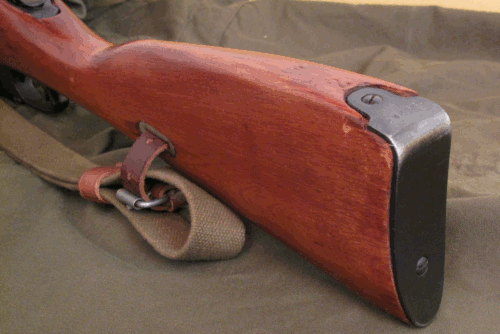Comparisons - 2

Bolt operation
The smoothest bolt action is by far the Mauser. There is no need to apply any excessive force at any point.
The Mosin-Nagant comes next. It is not as tight as the Mauser and the handle points up which is not "natural".
The Lee Enfield bolt requires a bit of force to push it forward. The striker is cocked during the final half inch of forward travel so the rifleman must push forward against the spring to close the bolt.
As for the semi-automatics, both are easy to operate. The only problem I have ever had is with the Tokarev, using poor quality surplus ammunition. The bolt would not cycle back and extract the round. I had to use a hammer to set it free (the round had been fired). This however was an ammunition problem.
One drawback with the M1 is that to close the bolt when the rifle is empty, one must push down on the follower arm, pull on the operating rod handle to release it and allow it to move forward. Getting your thumb stuck in there is not recommended!
Carrying the rifle
All rifles come with a sling for transport.
The Mauser, being the lightest and shortest, is the preferred rifle to carry around. Next come the Lee Enfield and the M1.
Finally the Russian rifles are the most tiresome to carry. They are quite long, making them difficult to move around with.
Recoil
I do not have any scientific measures to quantify the recoil. However here is my evaluation of the felt recoil.
| Mauser Karabiner 98 Kurz |     |
| Lee Enfield No.4 MK2 |    |
| Mosin-Nagant M91/30 |      |
| M1 Garand |   |
| Tokarev SVT-40 |      |
The butt length is almost the same for all rifles and is appropriate for the average person.
All have a metal butt plate which transfers the recoil energy quite well to the shoulder. The worst is - by far - the Mosin-Nagant, closely followed by the Tokarev. The metal plate has square edges and does not contour the shoulder very well.

The Mauser is well designed but it is light weight and the heavy load causes the felt recoil to be quite high.
Reloading
Complete reload: the use of stripper clips (or "en bloc" clips for the M1)
is efficient and quick. Simply align and push! There are some details involved,
but this site is not a rifles operation manual. 
Single round for the Mauser and the Tokarev: the round must first be pushed in the magazine. Otherwise the bolt cannot be pushed forward.
Single round for the Lee Enfield and the Mosin-Nagant: the round can simply be dropped in front of the bolt and the bolt pushed forward. The round does not need to be inserted in the magazine.
Single round for the M1 is the most complicated case. First put the round in the chamber, pull back on the operating rod handle, depress the magazine follower to release the bolt, allow it to travel forward, move your thumb out of the way and release the operating rod handle. The bolt will close and completly chamber the round. Be careful you do not catch your thumb in there!
Safety switch
The easiest switch to operate is the Lee Enfield as it only requires a small movement of the firing hand thumb. The M1 is a close second, requiring only to extend your finger to reach it.
The Mauser is very good but you need to free your firing hand to operate it.
On the Tokarev it is very ackward to disengage the safety since it is placed between the trigger and the trigger guard.
The one I dislike the most is on the Mosin-Nagant. It is ackward and requires quite a bit of force to operate. Moreover, when releasing the safety there is a risk of slam fire. I cannot imagine being engaged in a firefight and having to release that safety quickly!
Sights
M1 sights are way ahead of the others. They offer elevation and windage corrections with a positive "clic". No wonder this system was kept on the M-14. The aperture rear sight is still used on many nations service rifles today.
Similar sights are used on the Lee Enfield. The flip up ladder, used for long range engagements also has positive "clic" adjustments, but nothing for windage.
The Russian and German rifles all use the same sights. A rear notched ladder and a fixed front post. Altough efficient, I find it more difficult to use than the aperture sight. The ladder adjustment is also not as precise as on the American or English rifles.
Cleaning the rifle
| Mauser Karabiner 98 Kurz |  |
| Lee Enfield No.4 MK2 |   |
| Mosin-Nagant M91/30 |  |
| M1 Garand |      |
| Tokarev SVT-40 |     |
Bolt-action are much easier to clean than semi-automatics. Particularly the WWII semis. Simply remove the bolt and you have access to the barrel. Additionnaly, since there is no gas system, they stay cleaner to start with.
The Lee Enfield No.4 MK2 is a bit more complicated than it's fellow bolt-action rifles since there are more small parts, especially on the rear sight.
The M1 Garand is a major pain to clean. It must be completly disassembeld and there is no way of cleaning the barrel from the bore to the muzzle.
The Tokarev SVT-40 is easier to clean than the M1. The barrel can be cleaned from the bore to the muzzle (see the bottom of the SVT-40 page for a picture). And the gas system does not have to be dissassembled every time for a quick barrel cleaning.